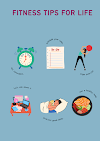Mental health refers to a person's overall psychological well-being. It encompasses emotions, thoughts, behaviors, and the ability to manage stress, relate to others and make healthy choices. Mental health can be influenced by various factors such as genetics, life experiences, and environment. Creative Ways to Improve Mental Health involves taking care of one's physical and emotional needs, seeking support when necessary, and adopting healthy coping strategies. Mental health disorders, such as anxiety and depression, can negatively impact a person's well-being and daily functioning, but effective treatments and support are available.
A brief overview of the Importance of Mental Health and How Creativity can Help Improve It.
Mental health is important for overall well-being and quality of life. It includes emotional, psychological, and social well-being. Creativity can be a helpful tool in improving mental health as it can provide an outlet for emotions, reduce stress and anxiety, and increase feelings of self-esteem and accomplishment. Engaging in creative activities, such as painting, writing, music, or cooking, can also promote mindfulness, boost mood, and foster a sense of connection and community. However, it's important to note that creative pursuits should not replace professional help for serious mental health concerns.
Explanation of Art Therapy and How it can Relieve Stress and Improve Mental Health.
Art therapy is a form of psychotherapy that uses art-making as a means of communication and expression. It is based on the idea that the creative process of making art can help individuals explore their emotions, thoughts, and experiences in a safe and non-threatening way.
Art therapy can relieve stress and improve mental health in several ways. First, it provides a outlet for emotional release, allowing individuals to process and express their feelings in a healthy way. Secondly, it can promote relaxation and mindfulness, helping to reduce anxiety and increase feelings of calm. Thirdly, creating art can help boost self-esteem and provide a sense of accomplishment, which can help improve overall mood and well-being.
Additionally, art therapy can provide a space for reflection and self-discovery, helping individuals gain insights into their thoughts, emotions, and behaviors. It can also be a form of self-care and provide a healthy distraction from daily stressors. However, it's important to note that art therapy should not be used as a substitute for traditional forms of mental health treatment and therapy.
Steps on How To Practice Art Therapy.
Here are some steps on how to practice art therapy:
- Find a quiet and comfortable space: Set aside time and a place where you can be alone and free from distractions to focus on your art-making.
- Gather materials: Choose materials that you feel comfortable working with, such as crayons, markers, paint, or even just paper and pencil.
- Set an intention: Take a moment to reflect on what you would like to achieve or express through your art-making. This can be anything from processing emotions to simply having fun and letting your imagination run wild.
- Start creating: Allow yourself to let go and simply enjoy the process of making art. There is no right or wrong way to do this, so let your imagination guide you.
- Reflect on your work: Once you have finished your art, take a moment to reflect on what it represents to you. What emotions, thoughts, or experiences does it bring up for you?
- Repeat: Art therapy is most effective when practiced regularly. So, try to make it a regular part of your self-care routine.
Explanation of Journaling and How it can be Therapeutic for Mental Health.
- Journaling is the act of writing down one's thoughts, feelings, and experiences in a personal diary or journal. It can be therapeutic for mental health in several ways.
- Emotional release: Writing about difficult emotions and experiences can help individuals process and release these feelings in a safe and controlled way.
- Increased self-awareness: Journaling can provide a space for self-reflection and introspection, helping individuals gain insights into their thoughts, feelings, and behaviors.
- Stress reduction: Writing about what is causing stress and anxiety can help to relieve these feelings, especially when combined with other stress-reduction techniques like deep breathing or meditation.
- Improved mood: Expressing gratitude and positive experiences in a journal can help boost mood and increase feelings of happiness and well-being.
- Increased insight and problem-solving: Writing about problems or challenges can help individuals gain new perspectives and develop creative solutions.
It's important to remember that journaling should not replace professional help for serious mental health concerns. However, incorporating journaling into your self-care routine can be a helpful tool in promoting overall well-being and emotional stability.
Steps on How to Practice Journaling for Mental Health Benefits.
- Here are some steps on how to practice journaling for mental health benefits:
- Choose a format that works for you: This can be a physical journal or a digital one, such as a note-taking app.
- Set aside dedicated time: Make journaling a regular part of your routine, such as first thing in the morning or before bed.
- Write without judgment or censorship: Allow yourself to write freely, without worrying about grammar, spelling, or making sense. The focus is on getting your thoughts and feelings down on paper.
- Write about your thoughts and emotions: Focus on what you are feeling and what is going on in your life. Try to be specific and descriptive.
- Reflect on what you have written: After you have finished writing, take a moment to reflect on what you have written. What insights have you gained? What do you need to work through?
- Repeat: Journaling is most effective when done regularly. So, try to make it a daily or weekly practice.
Remember, journaling is a personal process and should be tailored to your individual needs and preferences. The goal is to provide a space for self-expression and introspection, so allow yourself to be creative and open in your writing.
Explanation of Photography as a form of Therapy for Mental Health.
Photography can be a form of therapy for mental health because it provides a creative outlet for self-expression and helps to shift focus away from negative thoughts and emotions.
- Increased mindfulness: Paying close attention to the world around you through the lens of a camera can help promote mindfulness and increase feelings of calm and relaxation.
- Emotional release: Taking photographs can be a way to express emotions and experiences, helping to process and release difficult feelings.
- Improved mood: Capturing beauty in the world through photography can increase feelings of gratitude and improve overall mood.
- Increased self-esteem: Taking pride in one's photographs and seeing one's own progress over time can boost self-esteem and confidence.
- Improved social connections: Sharing photographs with others can foster deeper connections and provide a sense of community.
It's important to remember that photography should not replace professional help for serious mental health concerns. However, incorporating photography into your self-care routine can be a helpful tool in promoting overall well-being and emotional stability.
Steps on how to practice Photography for Mental Health Benefits.
Here are some steps on how to practice photography for mental health benefits:
- Choose a camera: You can use a traditional camera, a smartphone camera, or any device that you feel comfortable using to take photographs.
- Get out and explore: Take walks and go to places you have never been before to capture new and interesting images.
- Focus on the present moment: Pay attention to the world around you through the lens of your camera, focusing on the details and beauty in your surroundings.
- Experiment with different techniques: Try different techniques, such as macro photography or playing with light and shadow, to challenge yourself and improve your skills.
- Share your work: Share your photographs with friends, family, or through social media to build connections and get feedback.
- Reflect on your work: Take time to reflect on what each photo means to you and what emotions it brings up.
- Repeat: Photography is most effective when done regularly. So, try to make it a daily or weekly practice.
Remember, photography is a personal process and should be tailored to your individual needs and preferences. The goal is to provide a space for self-expression and creativity, so allow yourself to have fun and experiment with different styles and techniques.
Explanation of Dance Therapy and How it can Help Relieve Stress and improve Mental Health.
Dance therapy is a form of therapy that uses movement and dance to improve mental and emotional well-being. It can help relieve stress and improve mental health in several ways:
- Physical exercise: Dance therapy provides an opportunity for physical activity, which can release endorphins and reduce feelings of stress and anxiety.
- Emotional expression: Dance therapy allows individuals to express their emotions through movement, providing a release for feelings of anger, sadness, or frustration.
- Improved mood: Engaging in dance can boost mood and increase feelings of happiness and positivity.
- Increased self-awareness: Dance therapy can provide insights into an individual's thoughts, feelings, and behaviors, leading to increased self-awareness.
- Improved social connections: Participating in dance therapy with others can foster deeper connections and provide a sense of community.
It's important to remember that dance therapy should not replace professional help for serious mental health concerns. However, incorporating dance into your self-care routine can be a helpful tool in promoting overall well-being and emotional stability.
Steps on how to practice dance therapy.
Here are some steps on how to practice dance therapy:
- Find a comfortable space: Pick a space where you feel comfortable and can move freely.
- Choose music that resonates with you: Pick music that speaks to you on an emotional level and makes you feel good. This can be any type of music, from classical to pop.
- Let your body move: Allow your body to move to the music in any way that feels natural. Don't worry about style or technique, just let yourself move freely.
- Focus on the movement: Pay close attention to the movement of your body and how it feels. Try to let go of any distractions or worries.
- Reflect on how the dance makes you feel: After dancing, take a moment to reflect on how it made you feel. What emotions did it bring up? What insights have you gained?
- Repeat: Dance therapy is most effective when done regularly. So, try to make it a daily or weekly practice.
Remember, dance therapy is a personal process and should be tailored to your individual needs and preferences. The goal is to provide a space for self-expression and introspection, so allow yourself to be open and receptive to the power of movement.
Recap of How Creativity can be used to Improve Mental Health and Encourage Readers To Try it Out.
Creativity can be an effective tool for improving mental health and reducing stress. Some of the forms of creative expression that can have therapeutic benefits include:
- Art therapy: Using art as a form of self-expression can provide a release for emotions, improve mood, and increase self-awareness.
- Journaling: Writing down your thoughts and feelings can help process emotions and gain insights into your mental state.
- Photography: Taking photos can help shift focus from negative thoughts and provide a new perspective on experiences.
- Music therapy: Listening to music that resonates with you can boost mood, provide an emotional release, and increase self-awareness.
- Dance therapy: Engaging in movement to music can provide physical exercise, release emotions, improve mood, and increase self-awareness.
Incorporating creative expression into your self-care routine can provide a valuable outlet for stress and negative emotions. It can also foster deeper connections with yourself and others, leading to overall improvements in mental health. So why not give it a try? Experiment with different forms of creative expression to see which ones resonate with you and make it a part of your journey to better mental health.





0 Comments